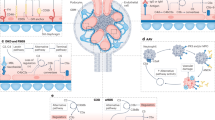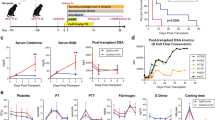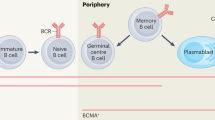Abstract
Over the past decade, several studies have suggested that the complement system has an active role in both acute and chronic allograft rejection. These studies have been facilitated by improved techniques to detect antibody-mediated organ rejection, including immunohistological staining for C4d deposition in the allograft and solid-phase assays that identify donor-specific alloantibodies (DSAs) in the serum of transplant recipients. Studies with eculizumab, a humanized monoclonal antibody directed against complement component C5, have shown that activation of the terminal complement pathway is necessary for the development of acute antibody-mediated rejection in recipients of living-donor kidney allografts who have high levels of DSAs. The extent to which complement activation drives chronic antibody-mediated injury leading to organ rejection is less clear. In chronic antibody-mediated injury, early complement activation might facilitate chemotaxis of inflammatory cells into the allograft in a process that later becomes somewhat independent of DSA levels and complement factors. In this Review, we discuss the different roles that the complement system might have in antibody-mediated allograft rejection, with specific emphasis on renal transplantation.
Key Points
-
Activation of the complement cascade by donor-specific alloantibodies (DSAs) might be the primary mechanism of acute antibody-mediated rejection (AMR) in sensitized kidney transplant recipients
-
Complement activation might cause injury by enhancing cellular infiltration and inflammation or by directly damaging the allograft
-
Blockade of complement component C5 with eculizumab reduces the incidence of early AMR in sensitized renal transplant recipients
-
The role of complement activation in chronic antibody-mediated injury is not yet clear: complement probably initiates intragraft inflammation, but might not be necessary for maintaining it.
-
Complement components might modulate T-cell activity and adaptive immune responses involved in allograft rejection
This is a preview of subscription content, access via your institution
Access options
Subscribe to this journal
Receive 12 print issues and online access
$209.00 per year
only $17.42 per issue
Buy this article
- Purchase on Springer Link
- Instant access to full article PDF
Prices may be subject to local taxes which are calculated during checkout



Similar content being viewed by others
References
Starzl, T. E. et al. The use of cyclosporine A and prednisone in cadaver kidney transplantation. Surg. Gynecol. Obstet. 151, 17–26 (1980).
Ferguson, R. Acute rejection episodes—best predictor of longterm primary cadaveric renal transplant survival. Clin. Transplant. 8, 328–331 (1994).
Tantravahi, J. R., Womer K. L. & Kaplan, B. Why hasn't eliminating acute rejection improved graft survival? Ann. Rev. Med. 58, 369–385 (2007).
Cosio, F. G. et al. Significance and implications of capillaritis during acute rejection of kidney allografts. Transplantation 89, 1088–1094 (2010).
Stegall, M. D., Gloor, J., Winters, J. L., Moore, S. B. & Degoey, S. A comparison of plasmapheresis versus high-dose IVIG desensitization in renal allograft recipients with high levels of donor specific alloantibody. Am. J. Transplant. 6, 346–351 (2006).
Patel, R. & Terasaki P. I. Significance of the positive crossmatch test in kidney transplantation. N. Engl. J. Med. 280, 735–739 (1969).
Issa, N. et al. Transplant glomerulopathy: risk and prognosis related to anti-human leukocyte antigen class II antibody levels. Transplantation 15, 681–685 (2008).
Feucht, H. E. et al. Vascular deposition of complement-split products in kidney allografts with cell-mediated rejection. Clin. Exp. Immunol. 86, 464–470 (1991).
Cohen, D. et al. Pros and cons for C4d as a biomarker. Kidney Int. 81, 628–639 (2012).
Trpkov, K. et al. Pathologic features of acute renal allograft rejection associated with donor-specific alloantibody: analysis using the Banff grading schema. Transplantation 61, 1586–1592 (1996).
Pei, R., Lee, J., Chen, T., Rojo, S. & Terasaki, P. I. Flow cytometric detection of HLA antibodies using a spectrum of microbeads. Hum. Immunol. 60, 1293–1302 (1999).
Solez, K. et al. Banff 07 classification of renal allograft pathology: updates and future directions. Am. J. Transplant. 8, 753–760 (2008).
Montgomery, R. A. & Zachary, A. A. Transplanting patients with a positive donor-specific crossmatch: a single center's perspective. Pediatr. Transplant. 8, 535–542 (2004).
Bartel, G. et al. Peritransplant immunoadsorption for positive crossmatch deceased donor kidney transplantation. Am. J. Transplant. 10, 2033–2042 (2010).
Vo, A. A. et al. Rituximab and intravenous immune globulin for desensitization during renal transplantation. N. Engl. J. Med. 359, 242–251 (2008).
Burns, J. M. et al. Alloantibody levels and acute humoral rejection early after positive crossmatch kidney transplantation. Am. J. Transplant. 8, 2684–2694 (2008).
Rother, R. P., Rollins, S. A., Mojcik, C. F., Brodsky R. A. & Bell, L. Discovery and development of the complement inhibitor eculizumab for the treatment of paroxysmal nocturnal hemoglobinuria. Nat. Biotechnol. 25, 1256–1264 (2007).
Hillmen, P. et al. The complement inhibitor eculizumab in paroxysmal nocturnal hemoglobinuria. N. Engl. J. Med. 355, 1233–1243 (2006).
Stegall, M. D. et al. Terminal complement decreases antibody-mediated rejection in sensitized renal transplant recipients. Am. J. Transplant. 11, 2405–2413 (2011).
US National Library of Medicine. ClinicalTrials.gov [online], (2012).
Lee, P.-C. et al. All chronic rejection failures of kidney transplants were preceded by the development of HLA antibodies. Transplantation 74, 1192–1194 (2003).
Gaston, R. S. et al. Evidence for antibody mediated injury as a major determinant of late kidney allograft failure. Transplantation 90, 68–74 (2010).
Sellares, J. et al. Understanding the causes of kidney transplant failure: the dominant role of antibody mediated rejection and nonadherence. Am. J. Transplant. 12, 388–399 (2012).
Haririan, A. et al. Positive cross-match living donor kidney transplantation: longer-term outcomes. Am. J. Transplant. 9, 536–542 (2009).
Lefaucheur, C. et al. Preexisting donor-specific HLA antibodies predict outcome in kidney transplantation. J. Am. Soc. Nephrol. 21, 1398–1406 (2010).
Stegall, M. D. et al. The histology of solitary renal allografts at 1 and 5 years after transplantation. Am. J. Transplant. 11, 698–707 (2011).
Lamb, K. E., Lodhi, S. & Meier-Kriesche, H. U. Long-term renal allograft survival in the United States: a critical reappraisal. Am. J. Transplant. 11, 450–462 (2011).
Cornell, L. D., Smith, R. N. & Colvin, R. B. Kidney transplantation: mechanisms of rejection and acceptance. Annu. Rev. Pathol. 3, 189–220 (2008).
Loupy, A., Hill, G. S., Nochy, D. & Legendre, C. Antibody-mediated microcirculation injury is the major cause of late kidney transplant failure. Am. J. Transplant. 10, 952; author reply 953 (2010).
Cosio, F. G. et al. Predicting subsequent decline in kidney allograft function from early surveillance biopsies. Am. J. Transplant. 5, 2464–2472 (2005).
Gloor, J. M. et al. Baseline donor-specific antibody levels and outcomes in positive crossmatch kidney transplantation. Am. J. Transplant. 10, 582–589 (2010).
Bentall, A. J. et al. Five-year outcomes in living donor kidney transplants with a positive crossmatch. Am. J. Transplant. (in press).
Haas, M. et al. Subclinical acute antibody-mediated rejection in positive crossmatch renal allografts. Am. J. Transplant. 7, 576–585 (2007).
Lerut, E., Naesens, M., Kuypers, D. R., Vanrenterghem, Y. & Van Damme, B. Subclinical peritubular capillaritis at 3 months is associated with chronic rejection at 1 year. Transplantation 83, 1416–1422 (2007).
Hidalgo, L. G. et al. Interpreting NK cell transcripts versus T cell transcripts in renal transplant biopsies. Am. J. Transplant. 12, 1180–1191 (2012).
Zhang, X., Rozengurt, E. & Reed, E. F. HLA class I molecules partner with integrin β4 to stimulate endothelial cell proliferation and migration. Sci. Signal. 3, ra85 (2010).
Li, F., Zhang, X., Jin, Y. P., Mulder, A. & Reed, E. F. Antibody ligation of human leukocyte antigen class I molecules stimulates migration and proliferation of smooth muscle cells in a focal adhesion kinase-dependent manner. Hum. Immunol. 72, 1150–1159 (2011).
Katsushige, A. et al. Enhanced expression of complement C5a receptor mRNA in human diseased kidney assessed by in situ hybridization. Kidney Int. 60, 137–146 (2001).
Shankland, S. J., Pippin, J. W. & Couser, W. G. Complement (C5b-9) induces glomerular epithelial cell DNA synthesis but not proliferation in vitro. Kidney Int. 56, 538–548 (1999).
Wavamunno, M. D. et al. Transplant glomerulopathy: ultrastructural abnormalities occur early in longitudinal analysis of protocol biopsies. Am. J. Transplant. 7, 2757–2768 (2007).
Dean, P. G., Park, W. D., Cornell, L. D., Gloor, J. M. & Stegall, M. D. Intragraft gene expression in positive crossmatch kidney allografts: ongoing inflammation mediates chronic antibody-mediated injury. Am. J. Transplant. 6, 1551–1563 (2012).
Sis, B. et al. Endothelial gene expression in kidney transplants with alloantibody indicates antibody-mediated damage despite lack of C4d staining. Am. J. Transplant. 9, 2312–2323 (2009).
Sis, B. & Halloran, P. F. Endothelial transcripts uncover a previously unknown phenotype: C4d-negative antibody-mediated rejection. Curr. Opin. Organ Transplant. 15, 42–48 (2010).
Sis, B. et al. A new diagnostic algorithm for antibody-mediated microcirculation inflammation in kidney transplants. Am. J. Transplant. 12, 1168–1179 (2012).
Everly, M. J. et al. Bortezomib provides effective therapy for antibody- and cell-mediated acute rejection. Transplantation 86, 1754–1761 (2008).
Locke, J. E. et al. The use of antibody to complement protein C5 for salvage treatment of severe antibody-mediated rejection. Am. J. Transplant. 9, 231–235 (2009).
Worthington, J. E., Martin, S., Al-Husseini, D. M., Dyer, P. A. & Johnson, R. W. Posttransplantation production of donor HLA-specific antibodies as a predictor of renal transplant outcome. Transplantation 15, 1034–1040 (2003).
Lee, P.-C., Zhu, L., Terasaki, P. I. & Everly, M. J. HLA-specific antibodies developed in the first year posttransplant are predictive of chronic rejection and renal graft loss. Transplantation 88, 568–574 (2009).
Everly, M. J. et al. Survival after the onset of de novo donor specific anti-HLA antibodies in a consecutive series of “low risk” renal transplant patients [abstract #180, 80]. Am. J. Transplant. 12 (Suppl. 3) 27–542 (2012).
Sacks, S. H. & Zhou, W. The role of complement in the early immune response to transplantation. Nat. Rev. Immunol. 21, 431–442 (2012).
Sutherland, S. M. et al. Complement-fixing donor-specific antibodies identified by a novel C1q assay are associated with allograft loss. Pediatr. Transplant. 16, 12–17 (2012).
Yabu, J. M. et al. C1q-fixing human leukocyte antigen antibodies are specific for predicting transplant glomerulopathy and late graft failure after kidney transplantation. Transplantation 91, 342–347 (2011).
Wahrmann, M. et al. Pivotal role of complement-fixing HLA alloantibodies in presensitized kidney allograft recipients. Am. J. Transplant. 6, 1033–1041 (2006).
Wahrmann, M. et al. Clinical relevance of preformed C4d-fixing and non-C4d-fixing HLA single antigen reactivity in renal allograft recipients. Transpl. Int. 22, 982–989 (2009).
Marcén, R. et al. Immunoglobulin class and specificity of lymphocytotoxic antibodies after kidney transplantation. Nephrol. Dial. Transplant. 3, 809–813 (1988).
Bryan, C. F. et al. IgM antibodies identified by a DTT-ameliorated positive crossmatch do not influence renal graft outcome but the strength of the IgM lymphocytotoxicity is associated with DR phenotype. Clin. Transplant. 15 (Suppl. 6), 28–35 (2001).
Taylor, C. J., Chapman, J. R., Ting, A. & Morris, P. J. Characterization of lymphocytotoxic antibodies causing a positive crossmatch in renal transplantation. Relationship to primary and regraft outcome. Transplantation 48, 953–958 (1989).
Barger, B. et al. Successful renal allografts in recipients with crossmatch-positive, dithioerythritol-treated negative sera. Race, transplant history, and HLA-DR1 phenotype. Transplantation 47, 240–245 (1989).
Stastny, P. et al. Role of immunoglobulin (Ig)-G and IgM antibodies against donor human leukocyte antigens in organ transplant recipients. Hum. Immunol. 70, 600–604 (2009).
Brodsky, S. V. et al. Expression of the decay-accelerating factor (CD55) in renal transplants--a possible prediction marker of allograft survival. Transplantation 88, 457–464 (2009).
Chen Song, S. et al. Complement inhibition enables renal allograft accommodation and long-term engraftment in presensitized nonhuman primates. Am. J. Transplant. 11, 2057–2066 (2011).
US National Library of Medicine. ClinicalTrials.gov [online], (2012).
Ferraresso, M. et al. Posttransplant ischemia-reperfusion injury in transplanted heart is prevented by a minibody to the fifth component of complement. Transplantation 86, 1445–1451 (2008).
Jang, J. H. et al. Increased local concentration of complement C5a contributes to incisional pain in mice. J. Neuroinflammation 7, 80 (2011).
Iyer, A. et al. Inhibition of inflammation and fibrosis by a complement C5a receptor antagonist in DOCA-salt hypertensive rats. J. Cardiovasc. Pharmacol. 58, 479–486 (2011).
Heeger, P. S. & Kemper, C. Novel roles of complement in T effector cell regulation. Immunobiology 217, 216–224 (2012).
Molina, H. et al. Markedly impaired humoral immune responses in mice deficient in complement receptors 1 and 2. Proc. Natl Acad. Sci. USA 93, 3357–3361 (1996).
Fang, Y., Xu, C., Fu, Y., Holer, V. M. & Molina, H. Expression of complement receptors 1 and 2 on follicular dendritic cells is necessary for the generation of a strong antigen-specific IgG response. J. Immunol. 160, 5273–5279 (1998).
Carter, R. H., Spycher, M. O., Ng, Y. C., Hoffman, R. & Fearon, D. T. Synergistic interaction between complement receptor type 2 and membrane IgM on B lymphocytes. J. Immunol. 141, 457–467 (1988).
Author information
Authors and Affiliations
Contributions
M. D. Stegall, M. F. Chedid and L. D. Cornell contributed equally to researching data for the article, discussions of the content, writing the article and review and/or editing of the manuscript before submission.
Corresponding author
Ethics declarations
Competing interests
M. D. Stegall and L. D. Cornell have received grant support from Alexion Pharmaceuticals. M. D. Stegall has also received grant support from Millennium Pharmaceuticals. M. F. Chedid declares no competing interests.
Rights and permissions
About this article
Cite this article
Stegall, M., Chedid, M. & Cornell, L. The role of complement in antibody-mediated rejection in kidney transplantation. Nat Rev Nephrol 8, 670–678 (2012). https://doi.org/10.1038/nrneph.2012.212
Published:
Issue Date:
DOI: https://doi.org/10.1038/nrneph.2012.212
This article is cited by
-
Inhibition of spleen tyrosine kinase decreases donor specific antibody levels in a rat model of sensitization
Scientific Reports (2022)
-
C3 complement inhibition prevents antibody-mediated rejection and prolongs renal allograft survival in sensitized non-human primates
Nature Communications (2021)
-
Eculizumab exposure in children and young adults: indications, practice patterns, and outcomes—a Pediatric Nephrology Research Consortium study
Pediatric Nephrology (2021)
-
Disseminated intravascular coagulation: new identity as endotheliopathy-associated vascular microthrombotic disease based on in vivo hemostasis and endothelial molecular pathogenesis
Thrombosis Journal (2020)
-
TNF-α promotes human antibody-mediated complement-dependent cytotoxicity of porcine endothelial cells through downregulating P38-mediated Occludin expression
Cell Communication and Signaling (2019)



